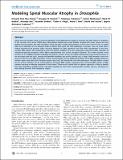| dc.contributor.author | Chang, Howard Chia-Hao | |
| dc.contributor.author | Yokokura, Takakazu | |
| dc.contributor.author | Mukherjee, Ashim | |
| dc.contributor.author | Kankel, Mark W. | |
| dc.contributor.author | Sridhar, Vasanthi | |
| dc.contributor.author | Hart, Anne C. | |
| dc.contributor.author | Dimlich, Douglas | |
| dc.contributor.author | Sen, Anindya Kumar | |
| dc.contributor.author | Fulga, Tudor Alexandru | |
| dc.contributor.author | Van Vactor, David L. | |
| dc.contributor.author | Artavanis-Tsakonas, Spiro | |
| dc.date.accessioned | 2013-01-28T17:00:05Z | |
| dc.date.issued | 2008 | |
| dc.identifier.citation | Chang, Howard Chia-Hao, Douglas N. Dimlich, Takakazu Yokokura, Ashim Mukherjee, Mark W. Kankel, Anindya Sen, Vasanthi Sridhar, et al. 2008. Modeling spinal muscular atrophy in Drosophila. PLoS ONE 3(9): e3209. | en_US |
| dc.identifier.issn | 1932-6203 | en_US |
| dc.identifier.uri | http://nrs.harvard.edu/urn-3:HUL.InstRepos:10235312 | |
| dc.description.abstract | Spinal Muscular Atrophy (SMA), a recessive hereditary neurodegenerative disease in humans, has been linked to mutations in the survival motor neuron (SMN) gene. SMA patients display early onset lethality coupled with motor neuron loss and skeletal muscle atrophy. We used Drosophila, which encodes a single SMN ortholog, survival motor neuron (Smn), to model SMA, since reduction of Smn function leads to defects that mimic the SMA pathology in humans. Here we show that a normal neuromuscular junction (NMJ) structure depends on SMN expression and that SMN concentrates in the post-synaptic NMJ regions. We conducted a screen for genetic modifiers of an Smn phenotype using the Exelixis collection of transposon-induced mutations, which affects approximately 50% of the Drosophila genome. This screen resulted in the recovery of 27 modifiers, thereby expanding the genetic circuitry of Smn to include several genes not previously known to be associated with this locus. Among the identified modifiers was wishful thinking (wit), a type II BMP receptor, which was shown to alter the Smn NMJ phenotype. Further characterization of two additional members of the BMP signaling pathway, Mothers against dpp (Mad) and Daughters against dpp (Dad), also modify the Smn NMJ phenotype. The NMJ defects caused by loss of Smn function can be ameliorated by increasing BMP signals, suggesting that increased BMP activity in SMA patients may help to alleviate symptoms of the disease. These results confirm that our genetic approach is likely to identify bona fide modulators of SMN activity, especially regarding its role at the neuromuscular junction, and as a consequence, may identify putative SMA therapeutic targets. | en_US |
| dc.language.iso | en_US | en_US |
| dc.publisher | Public Library of Science | en_US |
| dc.relation.isversionof | doi://10.1371/journal.pone.0003209 | en_US |
| dc.relation.hasversion | http://www.ncbi.nlm.nih.gov/pmc/articles/PMC2527655/pdf/ | en_US |
| dash.license | LAA | |
| dc.subject | neuroscience | en_US |
| dc.subject | neurobiology of disease and regeneration | en_US |
| dc.subject | neurological disorders | en_US |
| dc.subject | disease models | en_US |
| dc.subject | genetics | en_US |
| dc.subject | genomics | en_US |
| dc.title | Modeling Spinal Muscular Atrophy in Drosophila | en_US |
| dc.type | Journal Article | en_US |
| dc.description.version | Version of Record | en_US |
| dc.relation.journal | PLoS ONE | en_US |
| dash.depositing.author | Dimlich, Douglas | |
| dc.date.available | 2013-01-28T17:00:05Z | |
| dash.affiliation.other | HMS^Cell Biology | en_US |
| dash.affiliation.other | HMS^Cell Biology | en_US |
| dash.affiliation.other | HMS^Cell Biology | en_US |
| dash.affiliation.other | HMS^Cell Biology | en_US |
| dc.identifier.doi | 10.1371/journal.pone.0003209 | * |
| dash.authorsordered | false | |
| dash.contributor.affiliated | Dimlich, Douglas | |
| dash.contributor.affiliated | Fulga, Tudor Alexandru | |
| dash.contributor.affiliated | Sen, Anindya Kumar | |
| dash.contributor.affiliated | Artavanis-Tsakonas, Spyridon | |
| dash.contributor.affiliated | Van Vactor, David | |


